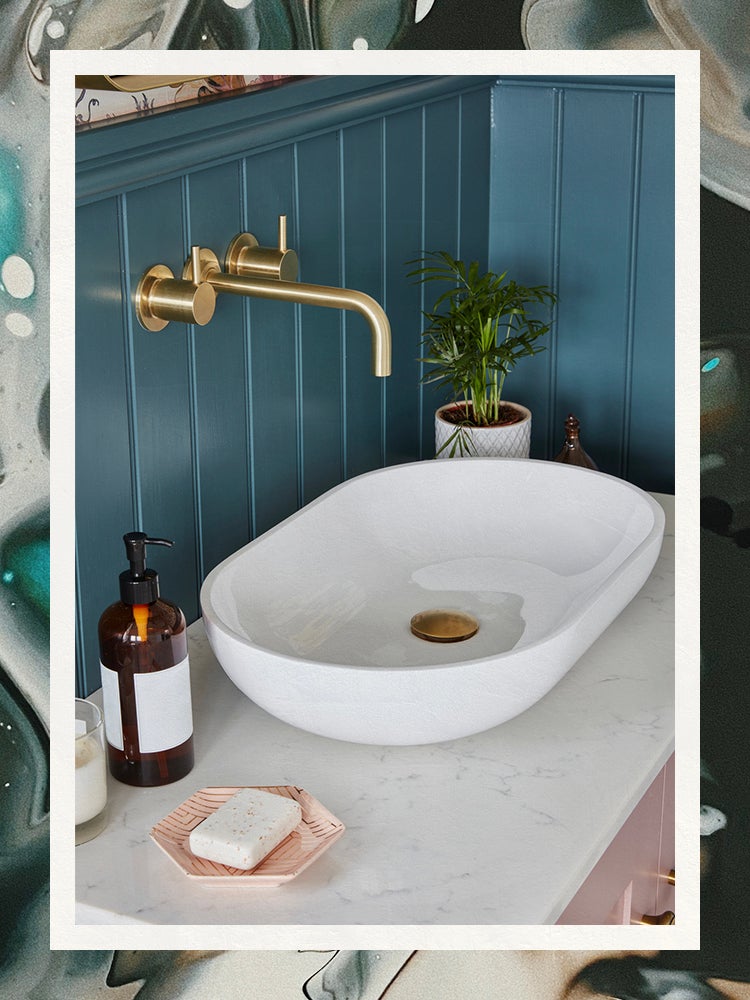Designer Insiders Share the Best Paint for Bathroom Walls, Ceilings, and More
Seven picks to revamp your steam-prone space.
Updated Oct 12, 2018 6:02 AM
We may earn revenue from the products available on this page and participate in affiliate programs.
Whether you have a teeny-tiny water closet or an expansive spa-like sanctuary, there’s more to choosing the best bathroom paint than picking the perfect color. That’s because this steamy space has to contend with a punishing combination of heat and moisture on a daily basis, making finding a durable mold- and mildew-fighting primer and finish just as important as deciding between a neutral or statement-making hue. The brushstrokes don’t stop at the walls: Nearly every bathroom surface—even your tub and tile—is paintable, so you’ll need to consider all of the possibilities. We tapped interior insiders to help narrow down the best bathroom paints for every surface, plus tips for pulling off a pro paint job no matter your experience level. With the right prep work and products (and patience), your dream bathroom is just a weekend away.
A Few Things to Keep in Mind
Oil versus latex: Despite its reputation for durability, oil is an outdated option that’s rarely used, and its chemical-defining solvent smell can take forever to dissipate. Unless a special circumstance warrants it, designers recommend water-based latex or acrylic paint for interiors, particularly in bathrooms. Both in look and longevity, latex has improved leaps and bounds in recent years; it also dries far more quickly, reducing the timeline of a days-long DIY to mere hours.
Color and finish: “Semigloss and satin are the best options for bathrooms because they’re the easiest to clean,” explains Tiffanni Reidy of Baltimore-based Reidy Creative. “They can be scrubbed with a sponge and stand up to harsher sprays because of their resin content, which creates a ‘harder’ surface.” On the flip side, flat finishes have a lower resin-to-pigment ratio, she says, making them more high-maintenance (watermarks are easily visible) and susceptible to peeling.
Once you’ve determined your preferred finish, spend time with your color choices to understand each shade’s subtle variations. Everything from the position of your windows to the reflective glare from your chrome hardware can impact how your eye perceives pigments. This is true of even simple whites, which can read yellow or gray and turn from calming to energizing (or worse, boring) depending on the light.
Prep: Paint becomes fickle in damp, moisture-prone areas, so precleaning and prepping is crucial for tackling textural issues before popping open a gallon of paint. Vacuum up dust and wipe away greasy fingerprints with a soft, soapy cloth; when dry, cure an undercoat (or pick a paint and primer in one) to avoid adhesion mishaps. And don’t forget the tiles. “If you’re not hiring a professional, take the time to scrape away any old paint splatter on your tile and remove the existing caulk,” suggests Chris McGovern, owner of New York interior design firm McGovern Project. “Use painter’s tape to get a crisp edge, and then conceal the seam.”
Our Top Picks
If you want an all-rounder: Aura Bath & Spa, Benjamin Moore
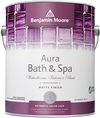
Benjamin Moore’s Aura Bath & Spa line promises premium, two-coat coverage and low odor release, plus prolonged durability against repeated scrubbing and washing—which is why Reidy loves it. The matte finish minimizes streaking but offers the same level of velvety color we’ve come to expect from the brand. And it comes in every shade in the fan deck, so you don’t have to choose between appearance and performance.
If it gets steamy: Perma-White Mold & Mildew-Proof Paint, Rust-Oleum
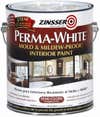
Almost all of the paints on this list offer some form of protection against moisture absorption, but the heavy-duty, antimicrobial gloss paints in Rust-Oleum’s Zinsser brand promise to prevent mildew from multiplying for at least half a decade. The best part? They’re self-priming and a cinch to clean. Past purchasers have applied them to ceilings—where moisture seems to get trapped most in all the hard-to-reach nooks and crannies—and have reported being mold-free for years.
If you have a small space: Premium Plus, Behr
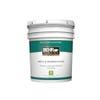
When it comes to tight quarters, designers often opt for whites and pretty pastels—but Behr’s Premium Plus line features an illuminating semigloss sheen that bounces light around no matter how saturated the shade for that ideal illusion of depth. It’s also well suited for high-moisture, high-traffic areas. Want to roll the dice on a striking hue? Magda Rauscher of My Modern Dom suggests adding some dramatic lighting for good measure.
If there’s no natural light: Eurolux, Fine Paints of Europe

A glossy, all-white approach isn’t always a surefire way to brighten a windowless bathroom. “I find a higher sheen paint will show all the imperfections of your wall, which are often exacerbated by brighter, artificial light,” says McGovern, who highlights Fine Paints of Europe’s 10,000-color Eurolux line as the perfect product to smooth older walls in spaces void of sunlight. He suggests choosing a bold, dark hue like Espresso or Coach Green, then bringing in other reflective materials, such as brass hardware, glass vases, or an extra-large mirror to distract the eye with the illusion of light.
If you want to make a statement: Lime Wall Paint, JH Wall Paints
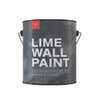
Tired of tile? If you’re looking to spice up your walls without relying on a freehand stencil or mural, Rauscher recommends limewash for a fresh take on Venetian plaster. The mineral-based natural material releases zero VOCs and has a high pH level that prevents mold from growing, she says, yet it also imparts an earthy, suede-like finish that envelops spaces with warmth and adds a dose of old-world European glamour. Rauscher combined two shades of gray to create an ombré-like accent wall for a recent client. But there are downsides: You’ll need to test out shades extensively before making a commitment. The dried hue can be up to 10 times lighter than its application color and depends on the number of coats as well as your wall’s porosity.
If you’re painting tiles: Suprema, Dunn-Edwards
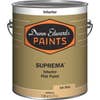
More than the paint itself, the primer and sealer are essential to refinishing wall and floor tile, notes Katie Zamprioli of Candy Coloured Home, who refreshed her own bathroom last summer. After making sure her floors were squeaky clean, Zamprioli layered two coats of bonding primer, waited 24 hours in between each, then started stenciling with Crystal Clear, Plumville, and Melting Violet from Dunn-Edwards’s Suprema line, an environmentally friendly, ultralow-emitting finish that has the rich texture she was looking for. “The quality of the paint is really smooth,” she says. “It’s held up great for me paired with the Sealkrete Concrete sealer top coat.” If you go this route and start to notice any wear, Zamproioli says not to worry: You can always reapply more sealer.
If you’re painting a tub: Tub and Tile Spray Paint, Rust-Oleum

Painting tubs are a thing: One couple turned their daughter’s bath into a permanent art installation with urethane-based marine paint typically used for boats. But if you’re just trying to get rid of stains that manage to defy dizzying levels of bleach, we recommend Rust-Oleum’s Tub and Tile Spray Paint. With a close to perfect 5-star rating and more than 4,000 positive reviews on Amazon, it promises to get your tub, tile, or sink looking good as new in just a few hours (plus a couple days of drying time). The $15 price tag alone makes it worth a try. But if you want to get daring with a color, don’t attempt to mix a random hue into a typical refinishing kit; look instead for a waterproof paint. Acrylic and cast-iron tubs are prime candidates for reglazing.
Ask Domino
What type of paint should I use to prevent mold?
Gross but true: Humidity-prone bathrooms are perfect breeding grounds for all sorts of microorganisms, especially if they’re cramped or suffer from poor ventilation. So look for a paint that includes mildewcides, fungicides, or other antimicrobial agents, notes Reidy. If mitigating moisture is out of your control, pick a primer that promises the same level of performance, too.
Can I use exterior paint in the bathroom?
Technically you can, but Brooklyn-based designer Emma Beryl doesn’t advise it. “Exterior paint has more chemicals than interior paint does” for added resistance against the elements, she explains. No matter how intense your water pressure is, your shower’s spray is not the same as rain, which is why it’s best not to use it in the bathroom (or any room, for that matter). Choose from high gloss to semigloss, or get really daring with something a bit more matte—all with mildew protection.
How We Vetted These Products
Every product in a Domino guide meets these criteria:
- They blend form and function. We believe the best-designed products reflect your personal style and are a joy to use.
- They’re expert approved. In addition to our team of editors, we tap a range of designers, makers, renovators, and all-around knowledgeable people to share their intel.
- They’re endorsed by people who actually own them. We pay close attention to real reviews to know that they pass the test IRL.
